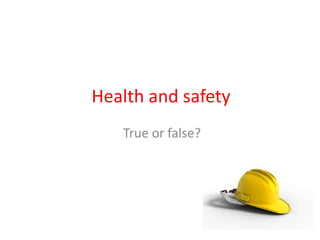
Health and safety: true or false?
- 1. Health and safety True or false?
- 2. Health and safety: True or false? 1. Health and safety regulations now ban the use of ladders. 2. School children are not allowed to use cardboard egg boxes in craft lessons on health and safety grounds. 3. Conkers have been banned in schools on health and safety grounds. 4. Workplaces are “risk averse” and employers are overly cautious because of the fear of health and safety regulations. 5. Firemen’s poles have been banned on health and safety grounds. 6. There are now more regulations and red tape than ever. 7. A local authority ordered the removal of St Georges’ flags from outside shops on safety grounds. 8. Small businesses are being strangled by over-inspection and over-regulation. 9. Trapeze artists will be forced to wear hard hats. 10. Health and safety regulations have fuelled a huge rise in compensation claims Source: Health and Safety Myths: A TUC Report October 2006
- 3. Health and safety regulations now ban the use of ladders. False This story reappears regularly. In fact there is no ban on ladders so long as they are used safely. There are regulations aimed at ensuring that people do use ladders safely. This is to reduce the number of workers seriously injured or killed falling off ladders every year. Each year an average 13 workers die this way and 12,000 are seriously injured. However there is no ban on ladders so long as they are secured and used appropriately.
- 4. School children are not allowed to use cardboard egg boxes in craft lessons on health and safety grounds. False This probably related to a decision by East Sussex County Council to issue a circular indicating that there were in fact no problems in using both egg boxes and toilet rolls as long as they were clean looking. This is standard guidance within education and makes perfect sense.
- 5. Schools have banned conkers False This story, more than any other epitomises the trivialisation of health and safety. In fact two schools are known to have asked children not to bring conkers in on the advice of doctors as children had severe nut allergies. In addition one primary school head teacher brought in safety goggles for his pupils to play conkers. However he stated that the reason behind this was that he wanted to make a statement over the increased fear of litigation. This point seems to have been lost on the media.
- 6. Workplaces are “risk averse” and employers are overly cautious because of the fear of health and safety regulations. False There is no evidence that employers are being “risk averse”. The fact that over a million workers get injured every year and 25,000 people are forced to give up work because of injury or illness caused by work shows that employers are very much taking risks with their workers health. Most of these injuries could have been avoided if employers had implemented proper safety procedures, but research has shown that around half of employers have not even done a simple risk assessment (a legal requirement).
- 7. There are now more regulations and red tape than ever. False In actual fact there were more than twice as many health and safety regulations and laws 35 years ago than there are now. The legislation that remains is now generally simpler and easier to understand.
- 8. A local authority ordered the removal of St Georges’ flags from outside shops on safety grounds. False This story originated in Liverpool, however Liverpool council did not ban St Georges’ flags or ask anyone to remove them. It did require one shopkeeper to properly secure flags after one fell onto the windscreen of a car causing an accident.
- 9. Small businesses are being strangled by over-inspection and over-regulation False The average small business is likely to be visited by a health and safety inspector around about once every 20 years. Even larger businesses, except for high hazards ones, are visited on average every 10 years. Small businesses are even exempted from some regulations. For instance while every employer has to do a risk assessment on their staff, if a business has less than 5 employees it does not even have to write the assessment down or record it. Hardly a major burden.
- 10. Trapeze artists will be forced to wear hard hats. False This story has appeared several times over the past few years. Sometimes the ban is blamed on European legislation, other times on the new Work at Height Regulations. The claim is that these regulations will require trapeze artists to wear hard hats. This is of course complete nonsense. The reason that hard hats are worn is to prevent people being hit from falling objects. Not to protect you if you fall. They are completely inappropriate for trapeze artists and there are no regulations, or plans for any regulations, to introduce them. A related story is that the Work at Height Regulations would mean that safety signs would have to be erected on the side of Snowdon. Again there is no truth in this.
- 11. Health and safety regulations have fuelled a huge rise in compensation claims False The number of civil claims for compensation against employers as a result of accidents has fallen every year for the last 5 years. In fact despite the introduction of “no win – no fee” claims the total cost of compensation cases in Britain has remained, in real terms, static since 1989. Britain also pays out much less in civil compensation, as a proportion of its economy, than any other major European country apart from Denmark, and a third that of the USA.